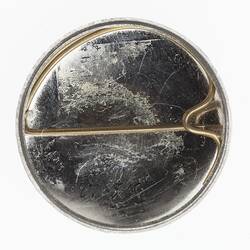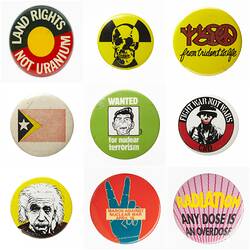Summary
Alternative Name(s): Button
This badge features an interesting if quite unusual design: the Eureka Flag juxtaposed with a radiation hazard symbol. The flag dates from the Eureka Rebellion in 1854 at Ballarat. The flag is a representation of the five brightest stars in the Southern Cross, a constellation which appears in the sky in the southern hemisphere. It was first used by the striking gold miners at Eureka, who were protesting the unfair mining license fees.
Since then, it has become a potent political symbol that has been adopted as a sign of democracy, protest, rebellion and unity. In the 1970s and 1980s it has been used on both sides of the political spectrum, both by republicans and nationalists as well as by members of the peace movement. Replicas of the Eureka flag were a common sighting at the Vietnam Moratorium Marches and Palm Sunday anti-nuclear marches. One activist named Lee White claimed that "Most Australians know what the Eureka Flag stands for. That it was the flag of people who were fighting for justice." The Eureka Rebellion has clearly been absorbed into the Australian socialist thought as an occurrence where the working class managed to rise up against the ruling classes. This view of the events fit perfectly with the nuclear disarmament protesters' anti-establishment intent.
This badge is, therefore, also an example of how the flag operated to convey the ideals of democracy and unity as well as protest and subversion, in this instance as part of a campaign opposing uranium mining. Australia was and still is one of the largest exporters of uranium worldwide, so many anti-nuclear campaigns in the region took this specific angle.
Physical Description
Circualr badge featuring uranium symbol in red under the Southern Cross Flag symbol in white over a blue background. White text scrolls across the top edge.
More Information
-
Collecting Areas
Public Life & Institutions, Politics & Society, Clothing & Textiles
-
Acquisition Information
Donation from Nic Maclellan, 23 Feb 1987
-
Collector
-
Inscriptions
Text white; NO URANIUM MINING
-
Classification
-
Category
-
Discipline
-
Type of item
-
Overall Dimensions
3.6 cm (Length), 3.6 cm (Height)
circular
-
Keywords
Anti-Nuclear Protests, Economic Geology, Nuclear Disarmament, Peace Issues, Political Protests, Protest Movements, Uranium Mining, Socialism, Activism





